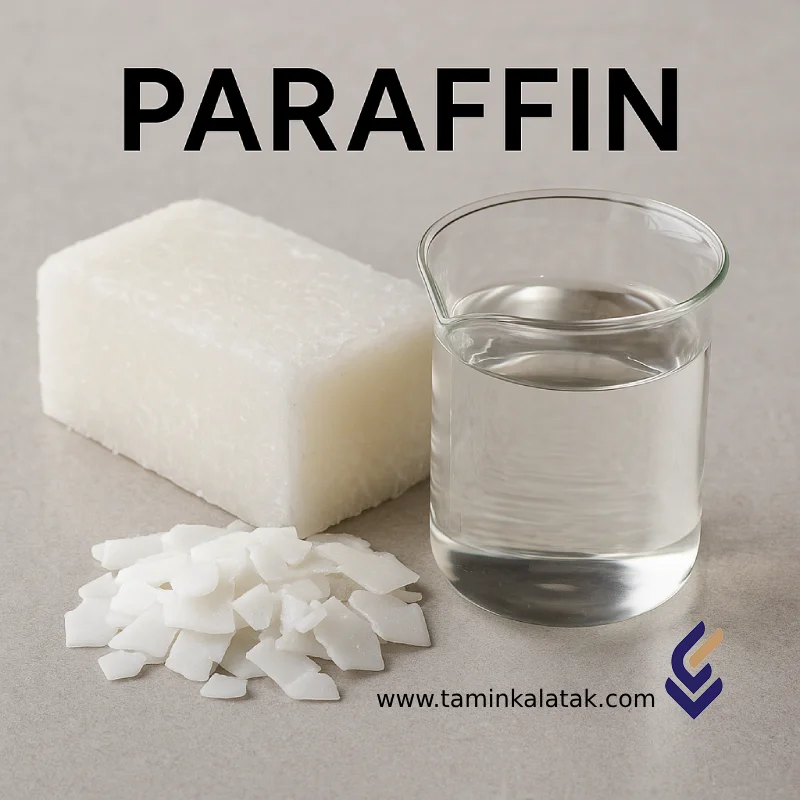paraffin
Paraffin is a general term for a group of saturated hydrocarbons (alkanes) primarily obtained from the distillation of crude oil, and in certain cases, from coal or natural gas. These compounds may exist in linear or branched forms. Paraffin can be found in solid, semi-solid, or liquid states, and depending on melting point, purity, molecular weight, and viscosity, it is available in various industrial, pharmaceutical, cosmetic, and food-grade forms.
Types of Commercial Paraffin
Commercial paraffins are generally available in two main types:
-
Solid Paraffin – used in candle manufacturing, pharmaceuticals, and personal care industries.
-
Liquid Paraffin – also known as Mineral Oil, available in industrial, cosmetic (pharmaceutical), and food-grade forms.
Chemical Structure of Paraffin
-
General Formula: CₙH₂ₙ₊₂ (representing saturated alkane compounds with single carbon–carbon bonds)
-
Structure: A chain of carbon and hydrogen atoms with no double bonds or rings; can be straight-chain or branched.
-
CAS Numbers (depending on the type):
-
Liquid Paraffin: 8012-95-1
-
Solid Paraffin (Paraffin Wax): 8002-74-2
-
Physical and Chemical Properties of Paraffin
| Property | Description |
|---|---|
| Physical state | Liquid (oily) or solid (white blocks or flakes) |
| Color and odor | Colorless or white; odorless or very faint odor (in purified grades); lower grades may have a slight odor |
| Viscosity (at 40 °C) | 2–30 cSt, depending on molecular weight and grade |
| Flash point | 150 °C to 220 °C (higher for heavier grades, lower for light liquid grades) |
| Solubility in water | Insoluble; soluble in organic solvents such as ether, chloroform, and benzene |
| Chemical stability | Chemically stable and inert; resistant to dilute acids and alkalis |
| Biodegradability | Slowly biodegradable in the environment; industrial grades may show cumulative environmental effects |
Applications of Paraffin
Cosmetic and Personal Care Industry
Paraffin is used as a base emollient and moisturizer in creams, ointments, lip balms, hair waxes, paraffin masks, and massage creams.
Pharmaceutical Industry
Used in pharmaceutical formulations for tablet coating, suppository production, and as an excipient or carrier in topical and transdermal preparations.
Food Industry
In food-grade form, paraffin is used for:
-
Coating fruits (e.g., apples) for gloss and preservation,
-
Coating chewing gum, cheeses, and dried foods to prevent moisture loss.
Candle, Match, Paint, and Rubber Industries
Solid paraffin is used in paraffin candle production, matches, shoe polish, waterproofing products, and as an additive in rubber compounding.
Industrial Lubricants
Liquid paraffin serves as a lubricating oil in textile machinery, metalworking, and light mechanical systems.
Petroleum and Drilling Industry
Used in drilling fluids as a drill oil, anti-corrosion coating, and friction-reducing agent in drilling tools.
Advantages of Paraffin
-
Chemically inert, non-toxic, and odorless in purified grades
-
Stable under various thermal and chemical conditions
-
Skin-compatible, suitable for cosmetic and pharmaceutical use
-
Low-cost, readily available, and recyclable
-
Resistant to weak acids and alkalis
-
Long-lasting and durable in industrial applications
Disadvantages of Paraffin
-
Flammable, especially in liquid form or under high temperatures
-
Petroleum-derived origin, raising environmental and sustainability concerns
-
May block skin pores upon prolonged contact, potentially causing acne
-
Lower grades may contain impurities such as sulfur, nitrogen, or heavy metals
-
When burned, it can produce pollutants such as soot and aldehydes
Applications
| Applications | , , , , , |
|---|
paraffin
| Products | Chemical formula | Grade | Solubility in water | Melting point | Density (at 20°C) | Physical appearance | Vapor pressure |
|---|---|---|---|---|---|---|---|
| Paraffin (Paraffin Wax و Liquid Paraffin) | CₙH₂ₙ₊₂ (long-chain linear or branched alkanes, usually n=20–40 for solids) | Industrial grade / Cosmetic grade / Pharmaceutical grade / Food grade | Insoluble in water – only soluble in organic solvents such as chloroform, ether, and benzene | Between 42 °C and 65 °C for the solid form; the liquid form usually has no specific melting point. | Between 0.77 and 0.89 g/cm³ depending on type and grade | Colorless clear liquid (for liquid type) / White or cream solid, odorless (for wax) | Very low; almost negligible for solid paraffin – less than 0.1 mmHg at 25°C |







